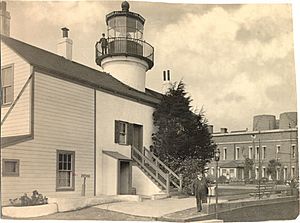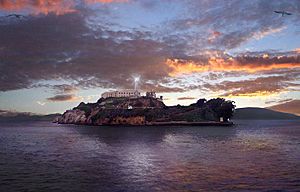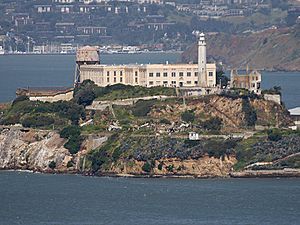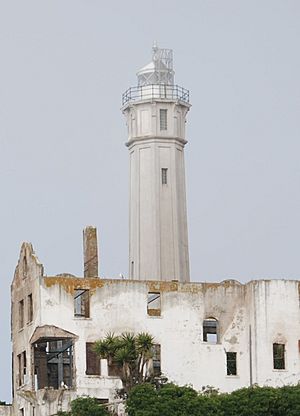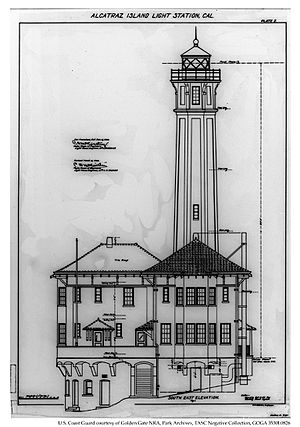Alcatraz Island Lighthouse facts for kids
| Location | Alcatraz Island, San Francisco Bay, California, United States |
|---|---|
| Coordinates | 37°49′34.5″N 122°25′19.8″W / 37.826250°N 122.422167°W |
| Year first constructed | 1854 (first) |
| Year first lit | 1909 (current) |
| Automated | 1963 |
| Foundation | Masonry basement |
| Construction | Reinforced concrete |
| Tower shape | Tapered octagonal tower with balcony and lantern |
| Markings / pattern | Unpainted tower, black lantern |
| Height | 84 feet (26 m) |
| Focal height | 214 feet (65 m) |
| Original lens | Third order Fresnel lens (removed), DCB-24 aerobeacon (current) |
| Range | 22 nautical miles (41 km; 25 mi) |
| Characteristic | Fl W 5s. |
The Alcatraz Island Lighthouse is a famous lighthouse located on Alcatraz Island in California's San Francisco Bay. It was the very first lighthouse built on the U.S. West Coast. You can find it at the southern end of the island, close to where the prison entrance used to be.
The first lighthouse on Alcatraz was finished in 1854. It helped guide ships while the island was used as a military fort and later a military prison. This original lighthouse was damaged in the big San Francisco earthquake of 1906. Because of this, a new, taller concrete tower was built in 1909. This new lighthouse stands 95 feet (29 m) above sea level.
In 1963, the lighthouse became automated, meaning it no longer needed people to operate it. This was the same year the Alcatraz Federal Penitentiary closed down. Today, the Alcatraz Lighthouse is the oldest light station on the island with a modern beacon. It is also part of the museum on Alcatraz Island. Even though it looks like the tallest building from far away, the Alcatraz Water Tower is actually taller. However, since the lighthouse is on higher ground, it appears much taller.
Contents
History of the Alcatraz Lighthouse
Long ago, Native American people were the first to visit Alcatraz Island. They would collect eggs from the many birds that lived there. The island got its name in 1775 during Spanish rule. A Spanish naval officer named Juan de Ayala explored the San Francisco Bay. He saw many pelicans on the island, so he named it "Isla de los Alcatraces," which means "Island of Pelicans." The island is more than 1 mile (1.6 km) away from the mainland.
The California gold rush brought many ships to the West Coast. The waters were often rough, making lighthouses very important for safety. The U.S. Congress understood this need. In 1851 and 1852, they passed laws to build seven lighthouses on the West Coast. These lighthouses would help guide ships safely.
A company from Baltimore, Gibbons and Kelly, won the contract to build these lighthouses. They built them in California at Alcatraz Island, Fort Point, Point Pinos, Point Loma, Farallon Island, and Humboldt Bay. They also built one at Cape Disappointment in Washington state.
The equipment for the lighthouses arrived in San Francisco on January 29, 1853. The Alcatraz Lighthouse was the first one to be finished in July 1853. This made it the oldest major navigational light on the West Coast. The foundation for the lighthouse had started even before the equipment arrived.
At first, the plan was to use older types of lamps and reflectors. However, the Lighthouse Board decided to use Fresnel lenses instead. These lenses, invented by Augustin Fresnel of France in 1822, were more expensive but worked much better. The company was told about this change before the equipment was shipped. The journey for the equipment was very long, over 12,000 miles (19,000 km) from the East Coast, going all the way around the tip of South America.
The first light on Alcatraz was lit on June 1, 1854. It used a fixed, third-order Fresnel lens. In 1902, this lens was moved to the Cape St. Elias Lighthouse in Alaska. A new, revolving fourth-order Fresnel lens was installed at Alcatraz. This new lens produced a white flash every five seconds.
Between 1909 and 1912, the main prison building (called the cell house) was built on Alcatraz. This new building would block the lighthouse's light. So, a taller, 25.6 metres (84 ft) concrete tower was built south of the original lighthouse. The original lighthouse had been damaged during the big San Francisco earthquake of 1906. It was eventually torn down.
In 1963, the United States Coast Guard made the Alcatraz Lighthouse automatic. This meant it could run on its own without keepers. In 1970, a fire destroyed the warden's house, the keepers' living areas, and other buildings on the island. The only building left was the tall concrete tower with its modern light. The lighthouse became a museum in 2000, and people can visit it today. For over 50 years, the lighthouse has stayed strong, even through prison escapes, the Battle of Alcatraz, and fires.
Lighthouse Design and Features
The first lighthouse was 50 feet (15 m) tall. It was designed in a "Cape Cod style". This meant the light tower was built right into the keeper's house, sitting on top of the roof. Building the foundation started in 1852. The house and light were finished in 1853. The lens arrived in October 1853, and Michael Cassin lit it on June 1, 1854. This was a big moment, as it was the first lighthouse on the Pacific Coast.
The old lighthouse was damaged in the earthquake on April 18, 1906. A new lighthouse was then built to the southeast of the old one. The old lighthouse stayed standing for a while next to the new one and was used as a storage building. But it was finally torn down between 1912 and 1913.
The lighthouse you see today is 84 feet (26 m) tall. It stands 214 feet (65 m) above sea level, south of where the first one was. Its base is made of stone, and the tower is shaped like an eight-sided pyramid made of concrete. The first lens was a third-order Fresnel reflector in 1854. This was replaced by a fourth-order reflector in 1903. The old foghorn bell was replaced with a modern electronic Klaxon. Near the bottom of the tower, there was also living space for three lighthouse keepers and their families.
Similar "Cape-cod style" lighthouses were built in other places. These included Point Loma in San Diego, Point Pinos near Monterey, and on Southeast Farallon Island, about 30 miles (48 km) west of the San Francisco Strait.
In the 1930s, a telephone was installed in the keepers' living area. Only the keepers knew about it and could use it. When the Federal Penitentiary opened on the island, more telephones were added, and others could use them too.
Lighthouse keepers were in charge of running and taking care of the lighthouse. They also operated the fog signals located at the northern and southern ends of the island. Prison guards helped the keepers with the foghorns. The guards were on high watchtowers and could see when "a bank of fog started to roll through the Golden Gate." They would then tell the keepers to turn on the foghorns.
Ships entering the island area use certain landmarks to guide them. These include Lime Point, which is 2.5 miles (4.0 km) east, and Black Point, which is 1 mile (1.6 km) north. The island itself has several buildings and old military towers. The lighthouse is on the highest part of the island.
Small buildings at the northwest and southeast tips of the island used to house the fog signals. These were electric horns in what were called "mid-twentieth century foghorn shacks." The white light from the grey tower flashes white for 0.5 seconds and then goes dark for 4.5 seconds. This light, along with the Fort Point lighthouse, helps ships cross the main shipping channel. The fog signals are electric sirens. The one on the southeast end makes two blasts, each lasting 4 seconds, every 30 seconds. The one on the northwest end gives a single blast, lasting 5 seconds, every 20 seconds.
Lighthouse Keepers
The three lighthouse keepers, sometimes called "wickies," wore special uniforms. These included a navy blue hat, a coat, a vest, and trousers. Their uniforms had decorative buttons and special patches. The keepers worked eight-hour shifts, and the light was on all year. During the day, the lens was covered to protect it from the sun.
Some of the head lighthouse keepers on Alcatraz Island included:
- Michael Cassin (1853–1855)
- John Sloan (1855–1856)
- Underwhill Van Wagner (1856–1862)
- Hartford Joy (1862–1872)
- Amasa Bushnell (1872–1874)
- William W. Scott (1874–1875)
- John A. F. McFarland (1875–1878, 1882–1888)
- John T. Huie (1878–1882)
- Benjamin F. Leeds (1888–1905)
- Henry W. Young (1905–1909)
- James Anderson (1909 – at least 1912)
- Frederick Arthur Harrington (1919–1938) was the keeper for both lighthouses until he passed away in 1938.
- Harry Davis (1938 – at least 1940)
- Edward H. Schneider (1950 – 1959)
- Norman Fornachon (at least 1962 – 1963)
Gallery
See also
- List of lighthouses in the United States


